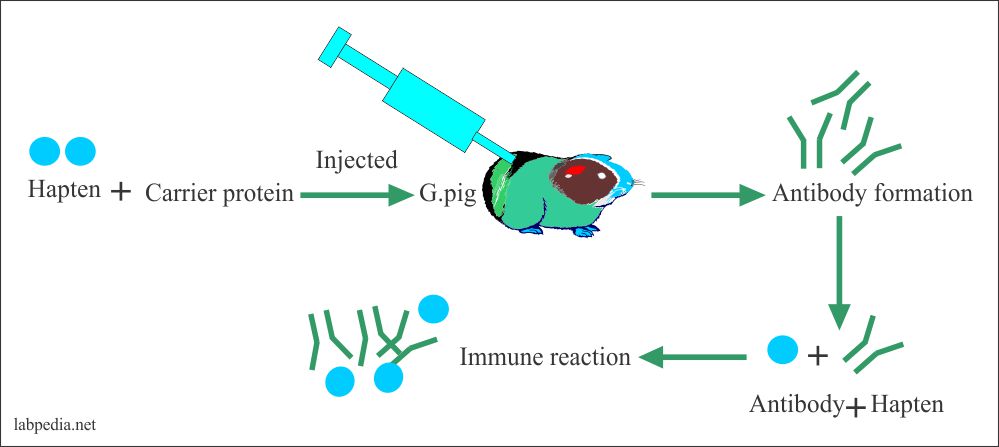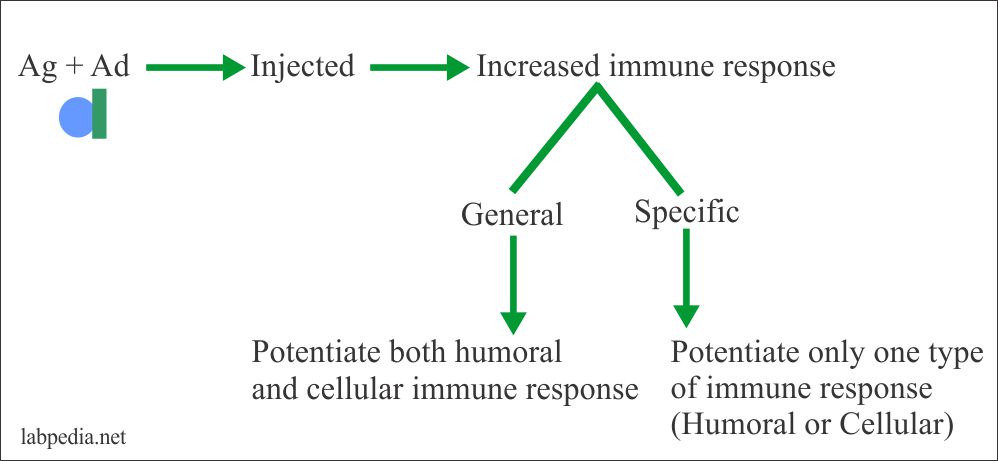Chapter 3: Immunogen and Antigen
IMMUNOGEN AND ANTIGEN
Definition of the immune response:
When foreign substances (Anigen, Ag) are introduced into the body, they lead to anti-foreign substance (Antibody – Ab) formation. These foreign substances may be bacteria, viruses, parasites, foreign proteins, etc. When entering the body, it gives rise to an immune response.
Immune response means antigenic challenge leads to activation of either B-lymphocytes or T-lymphocytes.
These foreign substances may be:
- Immunogenic when they can produce a specific immune response will stimulate immune cells and then give rise to immunological reaction (Humoral or cellular).
- Antigenic substances cannot yield directly immune response but need some help from some proteins (carrier proteins), and then they can react with antibodies.
All immunogens are antigenic, but not all antigens are immunogenic. In daily life, the word antigen is more commonly used.
ANTIGEN
The antigen may be:
- Complete
- Incomplete called Haptens
Properties of Antigen (Foreign Substances) to be Immunogenic:
A. Foreignness
This is the most important factor that the immune systems should recognize the substances as foreign (non-self).
The immune system develops a tolerance to self-antigens. In some of the diseases, there may be antibodies reacting against the self-antigens.
The cell membrane consists of protein, phospholipids, cholesterol, and a trace of carbohydrate, which are in the form of glycoproteins and glycolipids. Certain areas are antigenic determinants called epitopes. The bacterial capsule is also immunogenic, while bacteria without capsules have the surface structure, which is immunogenic.
- Autologous antigens are self-antigens, and there will be no immune response.
- Allogenic antigens are from the same species, and there may be a reaction, e.g., blood transfusion, kidney transplant, etc.
- Heterologous antigens are from different species. These will be rejected, and there will be a severe immune response.
- Antigens that degrades quickly can not stimulate the immune system, so the immune system needs adequate time for exposure to the antigen.
B. Chemical Nature
Antigens or immunogens are either proteins or large polysaccharides molecules and rarely, if ever, lipids.
These are cell surfaces or membrane-bound antigens.
The antigens or immunogens are the large organic molecules which may be:
- Proteins: These are powerful antigens. These are strong antigens because of their high molecular weight and structural complexity.
- Lipoprotein: These are part of the cells.
- Lipopolysaccharides: These are endotoxin, capsular polysaccharides of pneumococci, and other haptens.
- Carbohydrates (polysaccharides) are too small to be antigenic. But in the case of red blood cells, protein or lipid carrier gives rise to an increase in their size, and polysaccharides are present in the form of side chains and give rise to antigenicity.
- Red blood cell surface antigens are glycoproteins.
- Nucleic acid: These are non-immunogenic except for single-stranded DNA. These poor antigens because of the simplicity of the structure, molecular flexibility, and rapid degradation.
- Polypeptide: These are hormones, insulin and these are weak antigens.
- Nucleoproteins: These are strong antigens.
- Lipids: These are non-immunogenic except cardiolipin. These are very weak antigens because of simplicity and lack of structural stability. When these are combined with polysaccharides or proteins, then they may act as an antigen.
C. Molecular size (molecular weight)
The higher the molecular weight, the better the molecule will act as an antigen. The number of epitopes is directly proportional to the size of the antigen.
Haptens are tiny molecules, so they need to combine with the carrier (larger molecule) to be antigenic.
The larger molecules of antigens are more immunogenic because:
- These are easily phagocytosed.
- Antibody formation is increased if the antigens are processed by antigen-presenting cells (APC)
- The antigen, which is difficult for phagocytosis, is not immunogenic. If the molecular weight is >10,000, these are more immunogenic than the molecular weight of <10,000. See the example in the following table:
Also, amino acids and monosaccharides are not immunogenic.
D. Molecular Structure
The structural stability of the antigens is essential and always needed. If the structure is unstable, then it will be a very poor antigen.
This depends upon the chemical structural complexity. The more complex chemical structure is more potent immunogen than simple chemical structure substances, week immunogen.
For example, if protein consists of different aminoacid like A-B-C-D-G are a strong immunogen compared to A-A-A-A substance, which is a weak immunogen.
E. Route of Entry
Route of entry also influences the immune response. If it is exposed to the skin, it may see the localized reaction; if it enters blood circulation, then there is a generalized reaction. Possible route of entries are:-
- Natural: Gastrointestinal tract and respiratory system.
- Artificial: Subcutaneous, Intramuscular, and Intravenous.
F. The dose of the Immunogen
For adequate immune response, there is always a need for optimum dose; otherwise, there may be no reaction with a smaller dose and larger doses.
G. Genetic Host Relation
An immune response gene (1r gene) influences the immune response; it is different in different individuals.
EPITOPE
The epitope is an antigenic determinant, and these are small in size. These may be 4-5 aminoacid or monosaccharides.
These may be present on:
- The surface is called topographical.
- Internal only expressed after processing by the APC.
The antigen has a variable number of epitopes varying from one to hundreds, and this is called valency of antigen.
An epitope can be altered in the configuration by combination with other substances.
HAPTEN
This is the Greek word that means to fasten. These are partial antigens. These are not immunogenic. Mostly too small to be immunogenic.
Hapten needs carrier proteins like albumin, globulin, and synthetic polypeptide to become immunogenic.
Karl Land Steiner experimented:
He injected hapten with a carrier protein to Guinea Pig. The immune response took place; there was Antibody formation. Now he found that the antibody formed reacted with the hapten.
Examples are antibiotics, analgesics, penicillin, and alpha-methyldopa.
Therefore, haptens are antigenic and not immunogenic.
ADJUVANTS
This word is from Latin means “aiding and these are immunopotentiating agents. These are of two types:-
- General: – These potentiate both humoral and cellular immune responses.
- Specific: – These potentiate only one class, either B-lymphocytes (Humoral response) or T-lymphocytes (cellular response).
Mechanism
- The basic mechanism is that adjuvants give a slow release of antigen- adjuvant complex to the immune cells, so exposure time is prolonged.
- Adjuvants increase the size of the antigen.
- Adjuvants increase the efficiency of APC and increase lymphokines.
Functions
- Adjuvants increase antibody production.
- There is a decrease threshold dose of antigen.
- Adjuvants make weak antigens as potent and strong antigens.
General Adjuvant Examples
- Water and oil
- Aluminum hydroxide (Gel)
- Synthetic polynucleotide
- Bacterial endotoxin
Specific Adjuvants Examples
- Transfer factor (in cell-mediated immunity)
- Helper factor
Freunds Complete Adjuvant
It consists of killed Mycobacterium Tuberculosis and oil (in water emulsion). It increases cell-mediated response and antibody synthesis.
Freunds Incomplete Adjuvants
It consists of water in oil emulsion (water phase). It only increases the humoral response.






